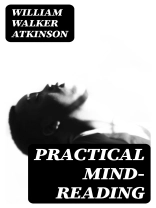In ‘Practical Mind-Reading, ‘ William Walker Atkinson delves into the intricate realm of telepathy and the subtleties of human thought communication. Atkinson employs a blend of psychological insights and metaphysical concepts, articulating a methodical approach to understanding and interpreting the thoughts and feelings of others. His literary style seamlessly merges instructional prose with anecdotal evidence, making the text accessible yet profound. Written in the early 20th century, this work reflects the burgeoning interest in psychological phenomena and the exploration of consciousness, laying the groundwork for future studies in mind-reading and interpersonal communication. Atkinson, a prominent figure in the New Thought movement and a prolific author, enjoyed a diverse career that included the practice of law and the study of Eastern philosophies. His eclectic background imbues ‘Practical Mind-Reading’ with an authoritative yet empathetic voice, illustrating his belief in the power of the mind and the interconnectedness of human experience. Atkinson’s life, characterized by an eagerness to push the boundaries of conventional thought, significantly informs his approach to understanding mental phenomena. For readers intrigued by the intersections of psychology, mysticism, and personal development, ‘Practical Mind-Reading’ offers invaluable insights. This book not only serves as a practical guide for enhancing interpersonal skills but also invites deeper contemplation of the latent potential within each individual. Atkinson’s work remains relevant, encouraging modern readers to explore the boundaries of human connection.
Sobre el autor
William Walker Atkinson (1862–1932) was an influential figure in the early 20th century’s New Thought movement, a philosophy which teaches that the mind is the key to unlocking personal power and spirituality. He was a prolific writer, attorney, merchant, and publisher. Atkinson began his professional life as a grocer, before becoming an attorney. However, after experiencing a mental and physical breakdown, and subsequently recovering, he became passionate about the power of the mind, which became a hallmark theme in his writings. One of his well-known works, ‘Practical Mind-Reading’ (1907), illustrates his fascination with the esoteric and the power of the mind, falling within the genre of mentalism and psychic phenomena. In this work, Atkinson delves into the techniques and implications of thought-transference, expanding on the timeless intrigue with human consciousness and psychic abilities. His writing reflects an analytical approach to what might be considered a mystical domain, providing exercises and practical guidance for those interested in exploring mind-reading. Atkinson wrote under several pseudonyms, notably Yogi Ramacharaka and Theron Q. Dumont, which allowed him to branch into various subjects like yoga, spirituality, and personal success, thus displaying his versatility and depth of knowledge on matters of the mind and human potential. His literary style combines a practical, instructional format with elements of motivational and inspirational discourse, which has been fundamental in shaping the paradigms of later New Thought authors and self-help movements.












